#Bibhutibhushan
Explore tagged Tumblr posts
Text
"মা ছেলেকে স্নেহ দিয়া মানুষ করিয়া তোলে, যুগে যুগে মায়ের গৌরবগাথা তাই সকল জনমনের বার্তায় ব্যাক্ত। কিন্তু শিশু যা দেয়, তা কি কম? সে নিঃস্ব আসে বটে, কিন্তু তার মন-কাড়িয়া-লওয়া হাসি, শৈশবতারল্য, চাঁদ ছানিয়া গড়া মুখ, আধ আধ আবোল-তাবোল বকুনির দাম দেয় কে? ঐ তার ঐশ্বর্য, ওরই বদলে সে সেবা নেয়, রিক্ত হাতে ভিক্ষুকের মত নেয় না।"
(পথের পাঁচালী; বিভুতিভূষণ বন্দোপাধ্যায়)
it's so amazing how bivutibhushon added these little yet meaningful things in the story. still reading the book and it really makes me want to get lost in apu-durga's little universe!!!
4 notes
·
View notes
Text

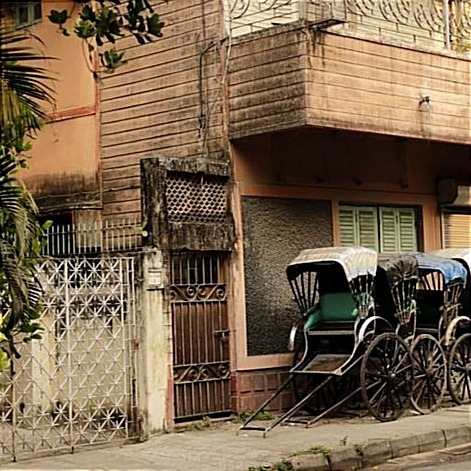



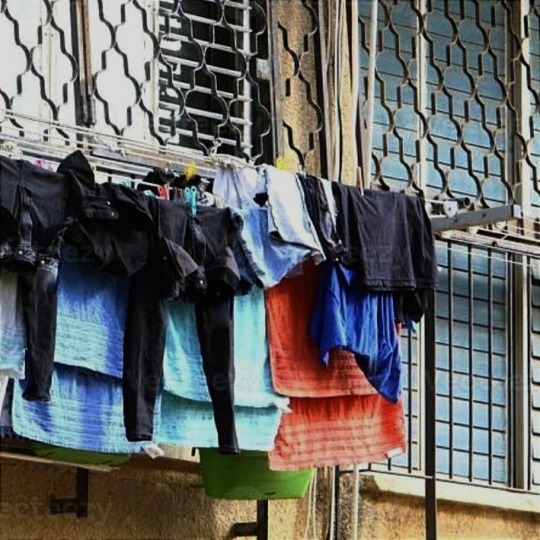

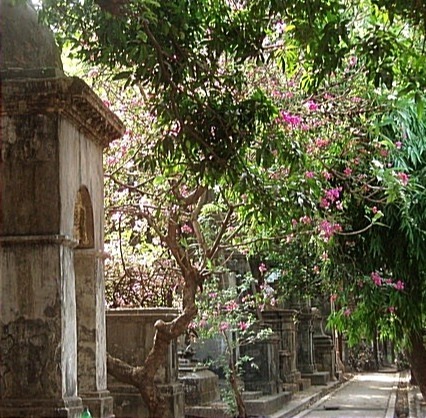
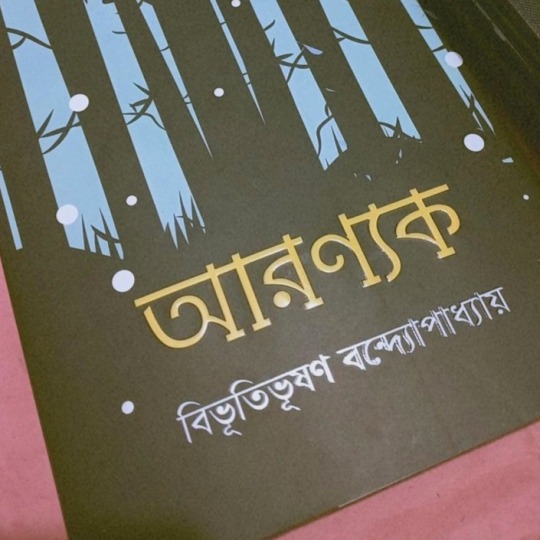
Moodboard for an OC
More OC moodboards X X X X
#finally the protagonist#trisha#moodboard#peevesie makes things#original content#bangla tag#bengblr#desi aesthetic#desi academia#dark academia#desi dark academia#bibhutibhushan bandyopadhyay#kolkata#desiblr#bengali
12 notes
·
View notes
Text

68 Years of Pather Panchali (26/08/1955).
Pather Panchali also known as 'Song of the Little Road,' is a groundbreaking drama film directed by Satyajit Ray in his directorial debut and funded by the West Bengal Government, the film is based on a 1929 novel of the same name by Bibhutibhushan Bandyopadhyay. The cast includes mostly newcomers like Subir Banerjee, Kanu Banerjee, and Karuna Banerjee, among others. The film is the first installment in Ray's Apu Trilogy and explores the struggles of young Apu and his sister Durga as they navigate the hardships of rural life in a financially struggling family.
The film's production faced numerous challenges, including financial constraints and a largely inexperienced crew, and took almost three years to complete. Despite these obstacles, the film was shot primarily on location and featured a memorable soundtrack composed by sitar virtuoso Ravi Shankar, based on traditional Indian ragas. Subrata Mitra managed the cinematography, while Dulal Dutta took care of the editing.
After its initial screening at New York's Museum of Modern Art in May 1955, the film was released in Calcutta to critical and commercial success, although it didn't turn a significant profit until the early 1980s. It received accolades from both the Chief Minister of West Bengal and the Prime Minister of India. While the film has been lauded for its realism and emotional depth, some critics have found its pacing slow and have criticized its romanticized depiction of poverty.
Academic discussions around the film often focus on its lyrical and realistic storytelling, influenced by Italian neorealism, as well as its nuanced portrayal of the complexities and simple joys of everyday life.
The story of Apu continues in the subsequent films of the trilogy, 'Aparajito' (The Unvanquished, 1956) and 'Apur Sansar' (The World of Apu, 1959). 'Pather Panchali' is considered a milestone in Indian cinema, contributing to the Parallel cinema movement that emphasized authenticity and social realism. The film garnered international acclaim, winning India's National Film Award for Best Feature Film in 1955 and the Best Human Document award at the 1956 Cannes Film Festival, among other honors. It is frequently cited in compilations of the greatest films of all time and solidified Ray's reputation as a leading figure in Indian filmmaking.
5 notes
·
View notes
Text
Bibhutibhushan Bandyopadhyay, “Mountains of the Moon”, 1937, PART TWO (II).
Monisha Rajesh मोनीषा राजेश ,”Around India in 80 Trains”, 2012 was the topic of an earlier blog post. Here I present: Bibhutibhushan Bandyopadhyay বিভূতিভূষণ বন্দ্যোপাধ্যায়ের “Mountains of the Moon” চাঁদের পাহাড় “Chander Pahar”, 1937, PART TWO (II). “Mountains of the Moon” was a metaphor for the search for the source of the Nile River by foreign explorers of AFRICA. INTRODUCTION. The story will…

View On WordPress
0 notes
Text
Satyajit Ray’s 'Pather Panchali' announced only Indian film on the new top 100 films of all-time list - Times of India
Satyajit Ray’s ‘Pather Panchali’ announced only Indian film on the new top 100 films of all-time list – Times of India
Satyajit Ray’s cult classic ‘Pather Panchali’ has been declared the only Indian film in the 100 Greatest Films of All Time. A renowned British magazine which first released their list of the greatest movies ever made in 1952 recently announced the new list and it sees Belgian director Chantal Akerman’s 1975 drama ‘Jeanne Dielman’, ’23 quai du Commerce’, ‘1080 Bruxelles’ as the top pick. Since the…
View On WordPress
#bibhutibhushan bandyopadhyay#chantal akerman#Jeanne Dielman#jordan peele#orson welles#Pather Panchali#ray#satyajit ray#Vittorio De Sica
0 notes
Note
Hii!! Just wanted to let you know I very much appreciate your posts about bengali culture and mythology :)
Btw, what other bengali books do you read? I'm big fan of Sukumar Ray (the whole Ray family honestly>>), i also love feluda among other things. I'd love to discuss bengali literature with you <3
First of all thank you so muchh :D
I have always been a fan of literature and mythology so I try to dig up as much as I can hehe
I have read some Chhoto Golpo by Rabindranath Thakur, he's my absolute favourite, my Gurudev. I have the Golpo Guchho, though I haven't complete read all of them till now, I plan to do very soon. Poems I've read a lot I guess I forgot, I know the story of Chokher Bali through movies and stuff, mom won't buy me that now cause I am too young for that she says. I LOVE LOVE LOVE rabindrasangeet trust me.
I have the Raj Kahini by Abanindranath Thakur in my to read list actually, I will read that once I complete the novel series I am reading currently. Cannot forget Khirer Putul, it was actually what my school did in my class 6th fest that was too memorable for me...
Other than that and Abol Tabol – I LITERALLY HAD ALL THE POEMS MEMORIZED AS A TODDLER – till now my bengali literature reach is not very much actually sadly... Though I do keep all my old school books and they have some great poems and stories in them.
But to ACTUALLY read, sadly I would have to get more books, which I plan to do very soon..
I have read the Chander Pahar by Bibhutibhushan Bandyopadhyay (the movie was bad but I did enjoy it as a child) and Aranyak I've only read a bit, it was in my school textbook I loved that and will read the entire thing oneday. but Pather Panchali I've read a bit, in a book called Aam Aatir Bhepu, – it was it also in my school syllabus – though I'd love to read someday, I have watched the movies OFCOURSE.
I have read some of Upendra Kishore Ray Choudhary too, like Banor Rajputro or Tuntunir Golpo. I read his Cheleder Ramayan too (that was the first ever Ramayan I ever read). Gupi Gayen Bagha Bayen, I've only watched the movies.
AND DON'T GET ME STARTED ON PANDOB GOYENDA. MY GOD I LOVE THAT SO MUCH. Bilu was my first ever crush ngl lol.. I still love him.
But sadly I haven't read any of them, including Feluda and Byomkesh Bakshi. My knowledge in them only goes till the movies and shows. I watched those ssoftoons animation Pandob Goyenda and Gopal Bhar – ANOTHER THING I ABSOLUTELY ADORE – I still have those DVDS but I broke my laptop (don't ask me but it was funny T_T) so I have to wait now till I can watch them again.
And other than that, I am an ABSOLUTE SUCKER for Thakumar Jhuli, like I love them so much. I can talk about them for hours.
I would love it, if you have some good suggestions for what I should read.
And I would love it even more to be able to talk to someone about Bengali literature and stuff.. even mythology because I am a sucker for that too lol..
#asked and answered#being bengali#bengali literature#bengali culture#rabindranath thakur#shukumar ray#satyajit ray#upendra kishor ray choudhury#bengali music#bengali girl#desiblr#desi tumblr#desi teen#desi tag#desi
25 notes
·
View notes
Text
—“The World of Apu” (অপুর সংসার, 1959) | By Satyajit Ray
Movie Adaptation: Aparajito By Bibhutibhushan Bandyopadhyay, 1931.

#satyajit ray#bengali movies#bengali cinema#bengali culture#cinestill#cinemetography#cinephile#cinema#film stills#movie stills#tv stills#episode stills#cinema stills#film analysis#film aesthetic#film and television#film adaptations#film art#film and tv#film scene#film photography#filmmaking#film#filmedit#drama movies#drama#comedy drama#comedy movies#black and white#bw film
3 notes
·
View notes
Text
Bibhutibhushan Bandopadhyay, a Bengali writer, lived in his own native land, yet he could describe places in quite a picturesque manner. He did work as a forest officer though.
For those who are getting to know him for the first time, I'd really recommend watching the film Chander Pahar with English subtitles. It's quite a family-friendly movie, if your kids can handle gore and action scenes. I'd rather say that it's better for teenagers though because of all the adventure through the mountains of Africa.
One of his stories I'm listening to is called "Moroner Donka Baje" (The Death Knell Resounds; the pronounciation is quite different from the word "moron," the first o in that word sounds more like 'a' from "ball").
A short synopsis: The story is set in the 1930s. It is from the POV of a medicine-seller and a doctor, who were trying to earn money by going overseas. Soon, they reach Rangoon and then to Singapore. From there, the two 'are (secretly) asked' if they could go as medical professionals to help the Chinese people and the soldiers against the Japanese invasion. From there, using a junk (a kind of boat), they try to reach Shanghai. What happens to them next?
One more thing I'd like to repeat: he neither visited Africa nor Shanghai. This 20th century writer relied solely upon the writings of others, including geographical/travel magazines.
If you're not much repulsed by research papers, you may read this one, because this is one of the only things written in English pertaining to this:
https://www.jstor.org/stable/44156606
4 notes
·
View notes
Text
The Apu Trilogy

Subir Banerjee in Pather Panchali (Satyajit Ray, 1955)
Cast: Kanu Bannerjee, Karuna Bannerjee, Chunibala Devi, Uma Das Gupta, Subir Banerjee, Runki Banerjee, Reba Devi, Aparna Devi, Tulsi Chakraborty. Screenplay: Satyajit Ray, based on a novel by Bibhutibhushan Bandyopadhyay. Cinematography: Subrata Mitra. Production design: Bansi Chandragupta. Film editing: Dulal Dutta. Music: Ravi Shankar.
When I first saw Pather Panchali I was in my early 20s and unprepared for anything so foreign to my experience either in life or in movies. And as is usual at that age, my response was to mock. So half a century passed, and when I saw it again both the world and I had changed. I now regard it as a transformative experience -- even for one whom the years have transformed. What it shows us is both alien and familiar, and I wonder how I could have missed its resonance with my own childhood: the significance of family, the problems consequent on adherence to a social code, the universal effect of wonder and fear of the unknown, the necessity of art, and so on. Central to it all is Ray's vision of the subject matter and the essential participation of Ravi Shankar's music and Subrata Mitra's cinematography. And of course the extraordinary performances: Kanu Bannerjee as the feckless, deluded father, clinging to a role no longer relevant in his world; Karuna Bannerjee as the long-suffering mother; Uma Das Gupta as Durga, the fated, slightly rebellious daughter; the fascinating Chunibala Devi as the aged "Auntie"; and 8-year-old Subir Banerjee as the wide-eyed Apu. It's still not an immediately accessible film, even for sophisticated Western viewers, but it will always be an essential one, not only as a landmark in the history of movie-making but also as an eye-opening human document of the sort that these fractious times need more than ever.

Smaran Ghosal in Aparajito (Satyajit Ray, 1956)
Cast: Pinaki Sengupta, Smaran Ghosal, Kanu Bannerjee, Karuna Bannerjee, Ramani Sengupta, Charuprakash Ghosh, Subodh Ganguli. Screenplay: Satayajit Ray, Kanaili Basu, based on a novel by Bibhutibhushan Bandyopadhyay. Cinematography: Subrata Mitra. Production design: Bansi Chandragupta. Film editing: Dulal Dutta. Music: Ravi Shankar
As the middle film of a trilogy, Aparajito could have been merely transitional -- think for example of the middle film in The Lord of the Rings trilogy: The Two Towers (Peter Jackson, 2002), which lacks both the tension of a story forming and the release of one ending. But Ray's film stands by itself, as one of the great films about adolescence, that coming-together of a personality. The "Apu trilogy," like its source, the novels by Bibhutibhushan Bandyopadhyay, is a Bildungsroman, a novel of ... well, the German Bildung can be translated as "education" or "development" or even "personal growth." In Aparajito, the boy Apu (Pinaki Sengupta) sprouts into the adolescent Apu (Smaran Ghosal), as his family moves from their Bengal village to the city of Benares (Varanasi), where Apu's father continues to work as a priest, while his mother supplements their income as a maid and cook in their apartment house. When his father dies, Apu and his mother move to the village Mansapota, where she works for her uncle and Apu begins to train to follow his father's profession of priest. But the ever-restless Apu persuades his mother to let him attend the village school, where he excels, eventually winning a scholarship to study in Calcutta. In Pather Panchali (1955), the distant train was a symbol for Apu and his sister, Durga, of a world outside; now Apu takes a train into that world, not without the painful but necessary break with his mother. Karuna Bannerjee's portrayal of the mother's heartbreak as she releases her son into the world is unforgettable. Whereas Pather Panchali clung to a limited setting, the decaying home and village of Apu's childhood, the richness of Aparajito lies in its use of various settings: the steep stairs that Apu's father descends and ascends to practice his priestly duties on the Benares riverfront, the isolated village of Mansapota, and the crowded streets of Kolkata, all of them magnificently captured by Subrata Mitra's cinematogaphy.
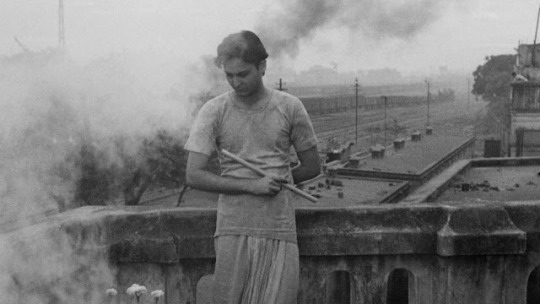
Soumitra Chatterjee in The World of Apu (Satyajit Ray, 1959)
Cast: Soumitra Chatterjee, Sharmila Tagore, Swapan Mukherjee, Alok Chakravarty, Dhiresh Majumdar, Dhiren Ghosh. Screenplay: Satyajit Ray, based on a novel by Bibhutibhushan Bandyopadhyay. Cinematography: Subrata Mitra. Production design: Bansi Chandragupta. Film editing: Dulal Dutta. Music: Ravi Shankar.
The exquisite conclusion to Ray's trilogy takes Apu (Soumitra Chatterjee) into manhood. He leaves school, unable to afford to continue into university, and begins to support himself by tutoring while trying to write a novel. When his friend Pulu (Swapan Mukherjee) persuades him to go along to the wedding of his cousin, Aparna (Sharmila Tagore), Apu finds himself marrying her: The intended bridegroom turns out to be insane, and when her father and the other villagers insist that the astrological signs indicate that Aparna must marry someone, Apu, the only available male, is persuaded, even though he regards the whole situation as nonsensical superstition, to take on the role of bridegroom. (It's a tribute to both the director and the actors that this plot turn makes complete sense in the context of the film.) After a wonderfully awkward scene in which Apu and Aparna meet for the first time, and another in which Aparna, who has been raised in comparative luxury, comes to terms with the reality of Apu's one-room apartment, the two fall deeply in love. But having returned to her family home for a visit, Aparna dies in childbirth. Apu refuses to see his son, Kajal (Alok Chakravarty), blaming him for Aparna's death and leaving him in the care of the boy's grandfather. He spends the next five years wandering, working for a while in a coal mine, until Pulu finds him and persuades him to see the child. As with Pather Panchali and Aparajito, The World of Apu (aka Apur Sansar) stands alone, its story complete in itself. But it also works beautifully as part of a trilogy. Apu's story often echoes that of his own father, whose desire to become a writer sometimes set him at odds with his family. When, in Pather Panchali, Apu's father returns from a long absence to find his daughter dead and his ancestral home in ruins, he burns the manuscripts of the plays he had tried to write. Apu, during his wanderings after Aparna's death, flings the manuscript of the novel he had been writing to the winds. And just as the railroad train figures as a symbol of the wider world in Pather Panchali, and as the means to escape into it in Aparajito, it plays a role in The World of Apu. Instead of being a remote entity, it's present in Apu's own back yard: His Calcutta apartment looks out onto the railyards of the city. Adjusting to life with Apu, Aparna at one point has to cover her ears at the whistle of a train. Apu's last sight of her is as she boards a train to visit her family. And when he reunites with his son, he tries to play with the boy and a model train engine. The glory of this film is that it has a "happy ending" that is, unlike most of them, completely earned and doesn't fall into false sentiment. I don't use the world "masterpiece" lightly, but The World of Apu, both alone and with its companion films, seems to me to merit it.
3 notes
·
View notes
Note
💌
Ei amaro chai 🤣💖
tumi hoccho unique miru didi. first didi on this site, a kind of parental figure bola jete pare, tomar sthan i alada<3
you remind me of maatir bhaar e cha, durga pujo, rajanigandha r mala. bangali dark academia personified, old libraries full of satyajit ray and bibhutibhushan's books, the feeling you get after watching hirok rajar deshe for the first time (euphoria, that is). udoyon pondit vibes, very gyaani. would 100% come to you for help with bio.
5 notes
·
View notes
Text
Hi? I am (secret) lol. She/her. Don't worry I'm an adult. I love various things actually, many hobbies. An Ideal intp-t?
I love music, games & movies/series. Specially bts, star wars, game of thrones, transformers, resident evil, the last of us, the weeknd, chase atlantic, the neighbourhood, arctic monkeys. (I can't remember rn, I'll add later)
Oh yes, i play Chess sometimes. I LOVE FOOTBALL! My ultimate team is Argentina & i support Fc Barcelona & Manchester City. But i love Jude Bellingham lol. Only thing i like about Real Madrid. I kinda like Basketball too. I support Golden State Warriors.
Sometimes i read books. My fav is Dostoevsky, Murakami, Dazai Osamu, Sharatchandra Chattopadhyay, Bibhutibhushan Bandopadhyay.
That's it maybe? Like someone cares lol.
Most important shit about me, I AM A PURE EMBARRASSMENT & I AM THE MOST BORING PERSON IN THE WORLD.
Thanks. 🫶
0 notes
Text

Historical & Mythological Thriller Bengali Audio Story । Megh Mollar । Bibhutibhushan Bandhopadhyay
Welcome again to our Bengali audio web story collection. This outstanding piece is a historical and mythological thriller by the majestic Bengali writer Bibhutibhushan Bandyopadhyay.
In this story of Bibhutibhushan Bandopadhyay we are going to enjoy the rural flavours of life while expressing various aspects of life. Here you will experience the taste of authentic Bengali entertainment natok with a spice of historical mythology.
In this channel we are happy to provide different types of Bengali entertainment web series to our listeners so that they can eventually enjoy all the aspects of life.
Visit our other laughing audio stories to enjoy your boring evenings with your family and friends.
Visit: https://youtu.be/ZDM6_Xu6frk?si=UhVP3uWuEoPcN4qE
#bengaliwebseries#bengaliaudiostory#banglawebseriesonyoutube#entertainimentwebseriesinbangla#bengaliwebstory#familywebseriesinbangla#laughingaudiostory#storyofbibhutibhushanbandapadhyay#Bengalientertainmentnatok#Bengaliaudiowebstory
0 notes
Text

I dare say that perusing a magnum opus is akin to beholding a commendable intellect. Yet, when one delves into the life of a sentient being, it is as though one's soul is elevated to the heavens. This must mirror the process undertaken by Naguib Mahfouz, the illustrious Egyptian author who conjured life within his own celestial garden, with the Cairo Trilogy as his botanical masterpiece. Presently, I am engrossed in the first volume, "Palace Walk." As a Bengali, I am intimately acquainted with "Pather Panchali," a dynamic magnum opus crafted by Bibhutibhushan Bandopadhyay. This work persistently lingered in my thoughts as I commenced reading Mahfouz's "Palace Walk." I endeavoured to recall the myriad memories associated with our journey through "Pather Panchali." Rather than noting mere resemblances, I prefer to underscore the shared themes of livelihood, familial bonds, and communal relationships. Despite a particular family's struggles within the confines of their specific religious society, which adheres rigidly to its doctrinal norms, the inexorable march of life continues. Nevertheless, individuals must discern their true desires as a family, their intrinsic needs, and what they genuinely seek from their community, which has become an ornament of grievances. They find themselves unable to discard it, yet bereft of it, they are left with naught.
1 note
·
View note
Text
Satyajit Ray: A Pioneer in Indian Cinema
One of the most influential filmmakers of the 20th century was Satyajit Ray,
an Indian director, screenwriter, and author. His works have made a lasting
impression on the history of global cinema, and he has made enormous
contributions to Indian cinema.
Early Life and Career
On May 2, 1921, Satyajit Ray was born in Kolkata, British India.
His mother, Suprabha Ray, was a vocalist, and his father,
Sukumar Ray, was a writer and poet. Early exposure to l
iterature, music, and the arts helped Ray cultivate a keen
aesthetic sensibility. He continued his education by enrolling
at Presidency College in Calcutta and Visva-Bharati University
in Santiniketan, where he first encountered the writings of
Rabindranath Tagore and other notable figures in Bengali literature.
Ray began working as a visualizer for a British advertising agency
in Calcutta after he finished his education. He spent more than ten
years working there, learning vital filmmaking skills that would later
be useful to him in his work as a director.
Also, he mastered the craft of filmmaking on his own by reading
books and watching movies.
Filmmaking Career
The first film made by Satyajit Ray, Pather Panchali
(Song of the Little Road), based on a book by
Bibhutibhushan Bandopadhyay, launched his
career as a director in 1955. The movie, which
was made on a tight budget with a mostly
unprofessional cast, is about a little child
growing up in rural Bengal. The movie was
a critical and financial hit and earned
numerous international honors, including
the 1956 Cannes Film Festival's Best Human
Documentary Award.
In what became known as the "Apu Trilogy,"
Ray went on to produce two further movies:
Aparajito (The Unvanquished) in 1956 and
Apur Sansar (The World of Apu) in 1959.
The trilogy focuses on the life of Apu, a young
man who matures in India after Independence.
Jalsaghar (The Music Room), released in 1958,
Charulata (The Lonely Wife), Nayak (The Hero),
released in 1966, and Ghare-Baire (The House
and the World), released in 1984, are some of
Ray's other well-known movies. His films gained
notoriety for their realism, lyricism, and meticulousness
. He was also a master of visual narrative, making excellent
use of lighting and camera angles.
In addition to being a filmmaker, Ray was also a writer,
composer, and graphic artist. He published a number of
works, including a Feluda-starring detective novella
collection. Together with designing the posters, he also
created the music for his movie.
Legacy
The impact Satyajit Ray had on Indian cinema is enormous.
His films continue to be praised for their realism, compassion,
and beauty. He is widely considered as the founder of Indian
art cinema. Many modern Indian directors, including Mira Nair,
Deepa Mehta, and Shekhar Kapur, have been influenced by him.
The Golden Lion at the Venice Film Festival, the Golden Bear
at the Berlin International Film Festival, and the Academy Honorary
Award for Lifetime Achievement are just a few of the countless
international accolades Ray's movies have received. He received
the Bharat Ratna, India's highest civilian honor, posthumously in 1992.
A heart attack and other health issues led to Satyajit Ray's
death on April 23, 1992, at the age of 70.Several of his
admirers and coworkers expressed their sorrow at his
passing, which was a major loss to Indian cinema. Ray
made a significant contribution to Indian cinema, and his
works are still praised for their beauty, compassion, and
realism. By his creative output and the impact he has on
present-day Indian filmmakers, his legacy endures.
1 note
·
View note
Note
cactus, jasmine, palm tree 🤍
Hi hello dani 🥰, thank you for sending in! Hope you’re being kind to yourself 💕

cactus ⇢ something you’re currently learning (about)?
hm... outside of the stuff i’m learning in college or including it? 🤔 y’know what, i’ll just add both things. so, in college, the most recent thing we finished learning was applied ecology! that was a while ago though lol. and outside all that, idk, greek and norse mythology? i binge watch this guy’s videos whenever i have time 😆, his animations and storytelling is so FUN i love it 🤭!
jasmine ⇢ do you have a movie or book you loved but will never watch/read again?
not really, i think? if i did love something, i think i’m really prone to revisiting it sometime later! although, there’s this work of art (read movie series) named “the apu trilogy” by satyajit ray, based on the novels “pather panchali” and “aparajito” by bibhutibhushan bandopadhyay (jeez i know, you don’t have to try to pronounce it hdgjsdh)... i think i read the novels when i was 12(?) and shortly after watched the movies. i haven’t been able to revisit them yet because it’s like a core memory of mine which is bittersweet, but god. i want to do it someday. it’s such a beautiful story and i’m gonna cry if i talk about it more but here are some wiki links for anyone who might be interested. 1, 2.
palm tree ⇢ do you have a fictional villain you shouldn’t like but love regardless?
damn... i think nah. “fictional villains i love” yeah there are several, however, “fictional villains i shouldn’t love”? ... no i don’t think i have any 😅

— random get to know me asks 💌
#📬; aleyna’s mailbox#🍶; ask games!#dani 🎡#🧚🏼♂��; mutuals!#jjunis#i apologize 🥲 these answers are so uninteresting 🥲#thank you tho <3#qphoria 𓍯
1 note
·
View note
Text
Michael Crichton (1942 - 2008), “Congo”, 1980.
Michael Crichton (1942 – 2008), “Congo”, 1980.
Bibhutibhushan Bandyopadhyay বিভূতিভূষণ বন্দ্যোপাধ্যায়ের “Mountain of the Moon” চাঁদের পাহাড় Chander Pahar, 1937 was an African adventure SciFi novel; and, the topic of an earlier blog post, Michael Crichton (1942 – 2008), “Terminal Man”, 1972 also was the topic of an earlier blog post. Here I present: Michael Crichton, “Congo”, 1980 which was an African adventure SciFi novel. Congo River…

View On WordPress
0 notes